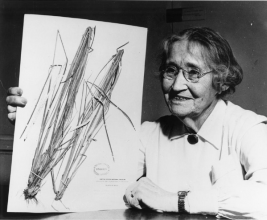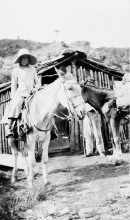Agnes Chase
- Agnes was not only a botanist, but a suffragist, pacifist, socialist and prohibitionist?
- Agnes donated her own herbarium specimens to the Smithsonian's U.S. National Herbarium?
- She was jailed twice and force-fed for her protest in front of the White House for women's right to vote?
- In 1929, at the age of 60, she went again to Brazil, where she climbed steep, jagged mountains, endured rain and biting insects, but collected grass specimens the whole way?
- Agnes took special interest in encouraging Latin American students to study botany, and often shared meals with them?
- She received an honorary Doctor of Science degree from the University of Illinois at age eighty-nine, and a Certificate of Merit at the Fiftieth Anniversary of the founding of the Botanical Society of America in 1956?
- In 1869, Mary Agnes Meara (later Chase) is born in Iroquois County, Illinois to an industrious mother and an Irish, railroad blacksmith father who died when Agnes was two years old.
- She begins type-setting and proofreading the School Heraldas a young adult, and marries the paper's 34-year-old editor, William Ingraham Chase.
- William passes away from tuberculosis one year after their marriage, and Agnes keeps his last name and continues to speak of him fondly throughout her life (and her ashes were interred beside his grave).
- After her husband's death, Agnes moves in with her brother-in-law, whose son, Virginius, encourages her to botanize.
- In 1963, Agnes passes away at the age of 95-years-old.
Mary Agnes Chase (1869-1963) became interested in botanical work when her brother-in-law’s 13-year-old son, Virginius, encouraged her to take him botanizing. After being inspired by the 1893 Columbian plant-collecting Exposition, Agnes began studying flora in northern Illinois and proof-reading for Inter Ocean newspaper. Being a talented illustrator, bryologist Rev. Ellsworth Jerome Hill asked Agnes to illustrate new species in return for teaching her all she knew of botany (yet another self-taught woman botanist).
In 1903, Hill convinced Agnes to apply for the job of botanical illustrator for the USDA Bureau of Plant Industry in Washington, D.C.—a job which she successfully got. In 1904 she began collaborating, as an illustrator, with Albert Spear Hitchcock, principal scientist in the systematic agrostology program. Between 1905 and 1912, Agnes explored grasses all over the continental United States, collecting specimens, which she used to create her book Manual of Grasses of the United States (published 1934).
In 1913, 1924, and 1929-1930, Agnes went to Brazil and collected so many grass specimens (in difficult physical conditions), that she increased the world’s knowledge of Brazilian grasses by at least 10 percent. She continued traveling and collecting specimens throughout her life and was named the eighth Honorary Fellow of the Smithsonian Institution in 1958.




